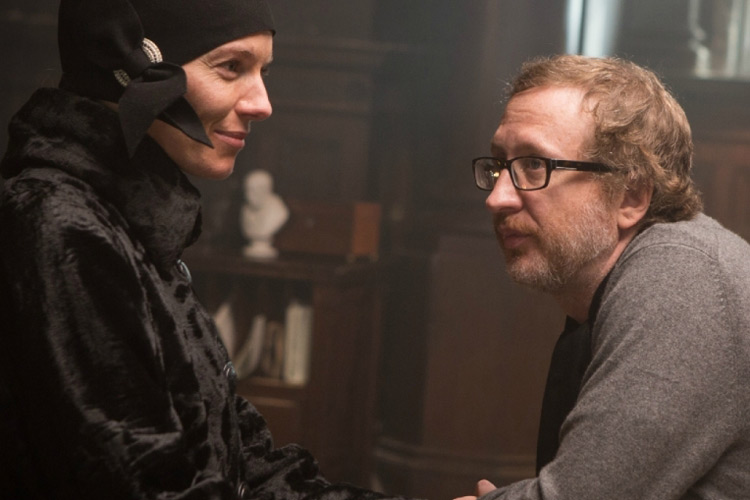The following questions and answers are excerpted from a conversation that followed the NBR screening of The Lost City of Z.
Can you discuss the process of adapting the book for the screen?
James Gray: The book is a meticulously researched thing. Immediately you realize that you’re in for it if you change something factually and of course I had to, because it’s a movie. Half of the book is concerned with David Grann, the writer, retracing Fawcett’s footsteps and I’ve seen that movie before. Knowing that movie already existed, I needed to take out the Grann stuff. This left me with something much more manageable that was essentially in a short story form. Then I moved the seven trips that Fawcett did in real life to three, one for each act of the film plus, the war. Ultimately the adaptation becomes something where you’re looking for a kernel of an idea and here it was to subvert the idea of going to the jungle and becoming mad. For Fawcett this is about reconnecting with these indigenous people that he scorned at first; he was for his time progressive. That for me formed the core of the story.
“I’ve been in that position where you’ve been lying awake and going a bit psycho all night about something.”
Nina Fawcett is a fascinating woman. What was it like researching and becoming her?
Sienna Miller: I think when I first read the script, my initial response was pity because it felt tragic from the perspective of a modern woman. The more I investigated, the more I realized her experience was quite common, as husbands would leave for long periods of time back then. She did feel a respect for him as she did stay home and raise the children. It was a feminist choice as she wasn’t a victim in that choice. She was frustrated because she’s ‘just a woman’ in that era, but I love the matriarchal aspect and how she just accepted her life with dignity. I love that the quest Percy’s on became her quest and she never gave up on him until the day she died.
How did you approach the scene where Nina and Percy have their worst argument?
Miller: I think she wanted to be heard and have some acknowledgement for what she experienced and felt. I’ve been in that position where you’ve been lying awake and going a bit psycho all night about something. I sort of loved that she’s just proving a point and bashing her head against the wall because she knows what she’s proposing isn’t realistic.
Gray: There was a lot of discussion centered around Sienna not wanting to “just be the wife.”
Miller: We butted heads a bit.
Gray: The thing that Sienna and I tried to say is that every single person is of value and has an independent humanity. I kept thinking of this quote by George Eliot, “we owe the artist of the extension of our sympathies,” and I thought that’s what it’s about. It wasn’t just Fawcett’s humanity, but also Nina’s. This is why I wanted to end it with her. The indigenous people of South America are independent and don’t need Percy to save them. This is all connected to what we try to make the core of the film, as opposed to a heroic white guy that loses his marbles.
How did shooting on film affect the process?
Miller: Flying reels out of the jungle every day…!
Gray: There are certain decisions that you make, and I don’t look back on it with regret, but it was totally nuts for me to do that. First, a lot has changed… for instance, film has gotten more expensive than when I made The Immigrant. It’s become more of a boutique thing now. Digital isn’t the same thing for me. When you say you can’t shoot on film, you’re taking away a basic tool and it’s the only artistic medium that forces the artist not to be able to access its history. I can’t shoot a black and white film now, for example, since it simply isn’t made any more. To your point, we were there and it was like trying to rev up the Model T and we trained this guy to be a film loader. He’d be in the jungle and you’d see him in the changing bag for a little longer than it would take you in film school. He’d put the film in the can and then in the cardboard box and the crop duster would take it away. You’d wave ‘bye’ to a day of work. “Bye bye, heart-poured-into-the-celluloid. Please get to London.” We did this every day.
How did you get the financing to make this film happen, given the deliberate nature of the story?
Gray: I have to tell you that I am so inept that I don’t look at this movie as slow (which is really what you’re saying, right?). I clearly have no clue because you’re not the first person to say that. I think it’s more of a style issue than a pace issue because it’s not how fast the actors are talking, instead it’s the cuts. My own taste is for letting the actors have space to perform. Slicing and dicing takes away that freedom. How did I convince producers? You kinda don’t. Directors are all bullshitters. I didn’t talk about pace, so I talked about what I wanted to accomplish.
Miller: Plan B is really focused — in the same way that I think Annapurna is — on filmmakers that a real actor wants to work with. Those two studios are the most invested in art, it seems to me.
Gray: That’s much more eloquent and shorter way of putting it. That’s the answer.

